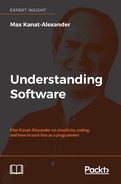Book Description
Software legend Max Kanat-Alexander shows you how to succeed as a developer by embracing simplicity, with forty-three essays that will help you really understand the software you work with.
About This Book
- Read and enjoy the superlative writing and insights of the legendary Max Kanat-Alexander
- Learn and reflect with Max on how to bring simplicity to your software design principles
- Discover the secrets of rockstar programmers and how to also just suck less as a programmer
Who This Book Is For
Understanding Software is for every programmer, or anyone who works with programmers. If life is feeling more complex than it should be, and you need to touch base with some clear thinking again, this book is for you. If you need some inspiration and a reminder of how to approach your work as a programmer by embracing some simplicity in your work again, this book is for you.
If you’re one of Max’s followers already, this book is a collection of Max’s thoughts selected and curated for you to enjoy and reflect on. If you’re new to Max’s work, and ready to connect with the power of simplicity again, this book is for you!
What You Will Learn
- See how to bring simplicity and success to your programming world
- Clues to complexity - and how to build excellent software
- Simplicity and software design
- Principles for programmers
- The secrets of rockstar programmers
- Max’s views and interpretation of the Software industry
- Why Programmers suck and how to suck less as a programmer
- Software design in two sentences
- What is a bug? Go deep into debugging
In Detail
In Understanding Software, Max Kanat-Alexander, Technical Lead for Code Health at Google, shows you how to bring simplicity back to computer programming. Max explains to you why programmers suck, and how to suck less as a programmer. There’s just too much complex stuff in the world. Complex stuff can’t be used, and it breaks too easily. Complexity is stupid. Simplicity is smart.
Understanding Software covers many areas of programming, from how to write simple code to profound insights into programming, and then how to suck less at what you do! You'll discover the problems with software complexity, the root of its causes, and how to use simplicity to create great software. You'll examine debugging like you've never done before, and how to get a handle on being happy while working in teams.
Max brings a selection of carefully crafted essays, thoughts, and advice about working and succeeding in the software industry, from his legendary blog Code Simplicity. Max has crafted forty-three essays which have the power to help you avoid complexity and embrace simplicity, so you can be a happier and more successful developer.
Max's technical knowledge, insight, and kindness, has earned him a status as a code guru, and his ideas will inspire you and help refresh your approach to the challenges of being a developer.
Style and approach
Understanding Software is a new selection of carefully chosen and crafted essays from Max Kanat-Alexander's legendary blog call Code Simplicity. Max’s writing and thoughts are great to sit and read cover to cover, or if you prefer you can drop in and see what you discover new every single time!
Downloading the example code for this book. You can download the example code files for all Packt books you have purchased from your account at http://www.PacktPub.com. If you purchased this book elsewhere, you can visit http://www.PacktPub.com/support and register to have the code file.
Table of Contents
- Understanding Software
- Table of Contents
- Understanding Software
- Credits
- About the Author
- www.PacktPub.com
- Customer Feedback
- Foreword
- One. Principles for Programmers
- Two. Software Complexity and its Causes
- Three. Simplicity and Software Design
- Four. Debugging
- Five. Engineering in Teams
- 18. Effective Engineering Productivity
- 19. Measuring Developer Productivity
- 20. How to Handle Code Complexity in a Software Company
- 21. Refactoring is about Features
- 22. Kindness and Code
- 23. Open Source Community, Simplified
- Six. Understanding Software
- 24. What is a Computer?
- 25. The Components of Software: Structure, Action, and Results
- 26. Software Revisited: (I)SAR Clarified
- 27. Software as Knowledge
- 28. The Purpose of Technology
- 29. Privacy, Simplified
- 30. Simplicity and Security
- 31. Test-Driven Development and the Cycle of Observation
- 32. The Philosophy of Testing
- Seven. Suck Less
- 33. The Secret of Success: Suck Less
- 34. How We Figured Out What Sucked
- 35. The Power of No
- 36. Why Programmers Suck
- 37. The Secret of Fast Programming: Stop Thinking
- 38. Developer Hubris
- 39. "Consistency" Does Not Mean "Uniformity"
- 40. Users Have Problems, Developers Have Solutions
- 41. Instant Gratification = Instant Failure
- 42. Success Comes from Execution, Not Innovation
- 43. Excellent Software
- Index
